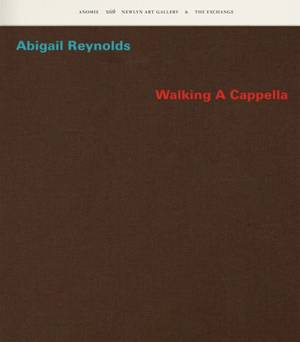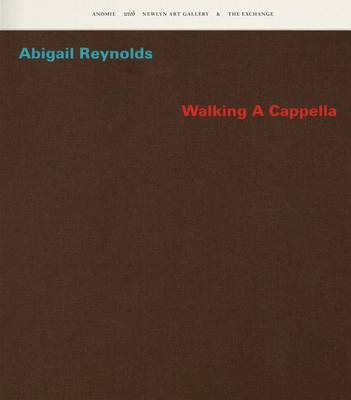
- Retrait en 2 heures
- Assortiment impressionnant
- Paiement sécurisé
- Toujours un magasin près de chez vous
- Retrait gratuit dans votre magasin Club
- 7.000.0000 titres dans notre catalogue
- Payer en toute sécurité
- Toujours un magasin près de chez vous
Abigail Reynolds - Walking A Cappella
Abigail Reynolds, Joanna Kavenna, Sophie J Williamson
Livre broché | Anglais
76,45 €
+ 152 points
Description
Abigail Reynolds writes the introduction to this book of her creative endeavors from her studio at Porthmeor in St Ives, where a strong Atlantic wind drives sand against salt-crusted windows and the sound of the surf fills the room. This elemental, shifting environment frames the making of Walking A Cappella, a book that reflects the looping and discursive nature of her artistic practice.
The publication presents a flow of images, sequencing works without regard to chronology or technique but allowing them to speak to one another formally. Recurring ideas and forms emerge intuitively, mirroring the way Reynolds returns to her core concerns from different directions. A dialogue with curator and writer Sophie J. Williamson threads through the sequence, alongside an essay by novelist Joanna Kavenna and a preface from Hammad Nasar.
Reynolds' work continually explores what lies beneath or behind: the unseen, the folded, the implied. She is interested in how much information can be held in tension, and how underlying structures shape experience. Her materials are often drawn from a personal library of books arranged in chronological order, beginning around 1890 when photography entered the public domain. The changing textures of paper and design across the decades of her book collection are echoed in the array of papers and typography arranged in signatures within Walking A Cappella. Earlier in her career, working for the Oxford English Dictionary in Duke Humphrey's Library, Reynolds honed a sensitivity to material history that remains central to her practice.
Reynolds works across sculpture, collage, print and live events. Using techniques such as overlay and folding, she reconfigures fragments of the past to sharpen our awareness of time. She is interested in disciplines from geology to palaeobiology, and collaborates with brass bands, choirs, and DJs. Her work frequently explores the contested histories of her home in far west Cornwall.
Reynolds studied English Literature at St Catherine's College Oxford University before receiving an MA in Fine Art at Goldsmiths College, University of London. In 2016 she was awarded the BMW Art Journey prize at Art Basel to travel to lost libraries along the Silk Road. Her book Lost Libraries documenting this journey was published by Hatje Cantz in 2018. Over 2020-22 her work was featured in British Art Show 9, the landmark touring exhibition that defines new directions in contemporary art. In 2019 she transformed the sand and seaweed of a local beach into perfect mouth-blown glass. Her work is well represented in public collections including New York Public Library, the Government Arts Collection, and the Arts Council Collection. Her sculpture Anthronauts: Trilobite commissioned by Chatsworth House is now on view at the Yorkshire Sculpture Park.
The publication presents a flow of images, sequencing works without regard to chronology or technique but allowing them to speak to one another formally. Recurring ideas and forms emerge intuitively, mirroring the way Reynolds returns to her core concerns from different directions. A dialogue with curator and writer Sophie J. Williamson threads through the sequence, alongside an essay by novelist Joanna Kavenna and a preface from Hammad Nasar.
Reynolds' work continually explores what lies beneath or behind: the unseen, the folded, the implied. She is interested in how much information can be held in tension, and how underlying structures shape experience. Her materials are often drawn from a personal library of books arranged in chronological order, beginning around 1890 when photography entered the public domain. The changing textures of paper and design across the decades of her book collection are echoed in the array of papers and typography arranged in signatures within Walking A Cappella. Earlier in her career, working for the Oxford English Dictionary in Duke Humphrey's Library, Reynolds honed a sensitivity to material history that remains central to her practice.
Reynolds works across sculpture, collage, print and live events. Using techniques such as overlay and folding, she reconfigures fragments of the past to sharpen our awareness of time. She is interested in disciplines from geology to palaeobiology, and collaborates with brass bands, choirs, and DJs. Her work frequently explores the contested histories of her home in far west Cornwall.
Reynolds studied English Literature at St Catherine's College Oxford University before receiving an MA in Fine Art at Goldsmiths College, University of London. In 2016 she was awarded the BMW Art Journey prize at Art Basel to travel to lost libraries along the Silk Road. Her book Lost Libraries documenting this journey was published by Hatje Cantz in 2018. Over 2020-22 her work was featured in British Art Show 9, the landmark touring exhibition that defines new directions in contemporary art. In 2019 she transformed the sand and seaweed of a local beach into perfect mouth-blown glass. Her work is well represented in public collections including New York Public Library, the Government Arts Collection, and the Arts Council Collection. Her sculpture Anthronauts: Trilobite commissioned by Chatsworth House is now on view at the Yorkshire Sculpture Park.
Spécifications
Parties prenantes
- Auteur(s) :
- Editeur:
Contenu
- Nombre de pages :
- 144
- Langue:
- Anglais
Caractéristiques
- EAN:
- 9781910221693
- Date de parution :
- 26-02-26
- Format:
- Livre broché
- Format numérique:
- Trade paperback (VS)
- Dimensions :
- 241 mm x 295 mm

Seulement chez Librairie Club
+ 152 points sur votre carte client de Librairie Club
Les avis
Nous publions uniquement les avis qui respectent les conditions requises. Consultez nos conditions pour les avis.






